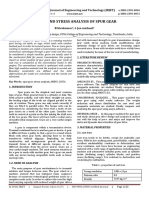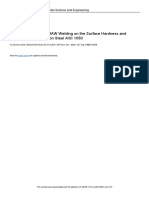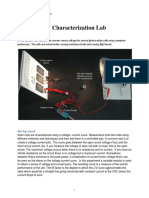Lecture 4 Materials Selection Process
Uploaded by
Yousab CreatorLecture 4 Materials Selection Process
Uploaded by
Yousab CreatorEME 4353 Advanced Engineering Materials
Materials Selection Process
(Week 2)
Learning Objectives
1. Describe the manner in which materials selection charts
are employed in the materials selection process.
Last Updated: 10/10/2019 © I-Station Solutions Sdn Bhd 2
Materials Selection – Mechanical Properties
1. Stiffness or resistance to bending of
a material is related to its elastic
modulus.
2. Strength or yield strength refers to
the ease the material can deform
permanently under stress
3. K1C is the fracture toughness. A
high value means the material is
tough or doesn’t fracture easily.
4. Materials with low density is
essential in most mechanical
applications.
Last Updated: 10/10/2019 © I-Station Solutions Sdn Bhd 3
Materials Selection Chart
Last Updated: 10/10/2019 © I-Station Solutions Sdn Bhd 4
• Systematic selection for applications requiring multiple criteria is
more complex. For example, a rod which should be stiff and light
requires a material with high Young's modulus and low density.
• If the rod will be pulled in tension, the specific modulus, or modulus
E
divided by density , will determine the best material.
E1 2
• For loading conditions that could lead to buckling,
applies
E 1/ 3
• For a stiff beam in bending, the material index is
Last Updated: 10/10/2019 © I-Station Solutions Sdn Bhd 5
Nature of Materials Selection Process
1. Analysis of Materials Performance requirements include:
a) Functional requirements
b) Processability requirements
c) Cost
d) Reliability requirements
e) Resistance to service conditions
2. These can be classified into two main categories:
a) Rigid, or go/no-go, requirements – must be met
b) Soft, or relative, requirements – subject to
compromise and trade-offs
Last Updated: 10/10/2019 © I-Station Solutions Sdn Bhd 6
Functional Requirements
- Directly related to required characteristics of the part or
product
- E.g. for parts carrying tensile load, the yield strength
of a candidate material can be directly related to the
load-carrying capacity of the product
- Not all characteristics of the product have a direct simple
correspondence with measurable material properties.
- E.g. thermal shock resistance, wear resistance,
reliability, etc
- Depends upon predictions from simulation tests or
most closely related properties.
Last Updated: 10/10/2019 © I-Station Solutions Sdn Bhd 7
Processability Requirements
- A measure of materials ability to be worked and shaped:
Shaping Joining
Finishing
E.g. casting, Machining E.g.
Raw E.g.
molding, and heat adhesives,
Materials polishing,
powder treatment welding,
coating,
metallufry fasteners
Last Updated: 10/10/2019 © I-Station Solutions Sdn Bhd 8
Cost
1. Engineering materials can be classified into two main categories:
a) Common (cost effective) – plain carbon steels, polyethylene
b) High performance (expensive) – superalloys
2. Efforts should be made to achieve overall reduction of product cost
(including machining cost, recovery of scrap material)
Candidate materials for suspension member
Material Yield Specific Relative Cross- Relative cost
strength gravity cost (to AISI sectional of member
(MPa) 1015) area (mm2)
AISI 1015 329 7.8 1 152 1
AISI 1040 380 7.8 1.1 132 0.95
AISI 4820 492 7.8 1.8 102 1.2
Brass 532 8.5 7 94 4.7
Last Updated: 10/10/2019 © I-Station Solutions Sdn Bhd 9
Reliability Requirements
1. Defined as probability that the material will perform the
intended function for the expected life without failure
• Non-standard materials will have lower reliability
2. Failure analysis techniques are usually used to predict
the different ways a product can fail
• Causes of failure can be traced back to defects in
materials and processing, faulty design or
unexpected service conditions
Last Updated: 10/10/2019 © I-Station Solutions Sdn Bhd 10
Resistance to Service Conditions
1. Operating condition plays an important role in
determining the material performance requirement i.e.
corrosive and extreme temperature environment
2. Compatibility of the materials is also crucial.
• Thermal environment – similar coefficients of thermal
expansion to avoid thermal stresses
• Wet environment – avoid galvanic corrosion
Last Updated: 10/10/2019 © I-Station Solutions Sdn Bhd 11
Primary Function, Constraints and Objectives
• 3 fundamental factors about component and operation:
1. Primary function – main functional purpose of component
2. Constraints – factors which limit performance
3. Objectives – aim(s) of a particular design/selection process
• Example 1: To produce a bicycle frame weighing less
than 5 kg at minimum cost.
Constraint: mass
Objective: cost
• Example 2: To produce a bicycle frame which costs less
than $100 at minimum mass
Constraint: cost
Objective: mass
Last Updated: 10/10/2019 © I-Station Solutions Sdn Bhd 12
Torsionally Stressed Cylindrical Shaft
Assumption:
Twisting moment and length of the shaft are specified
(fixed variables), the radius may be varied (free variable)
Application of twisting moment (or torque), t produces an
angle of twist.
Last Updated: 10/10/2019 © I-Station Solutions Sdn Bhd 13
Calculating minimum mass of shaft
Shear stress at radius r: and J
Tr r 4
J 2
2T f 2T
Thus, r 3 or N r 3 where N is the safety factor
Since mass of shaft, m=r2L
Solving the 2 equations give:
( )
Minimum mass can be achieved by minimizing f 2/3
Last Updated: 10/10/2019 © I-Station Solutions Sdn Bhd 14
Performance index
Performance index, P is f
2/3
( )
Taking the logarithm scale of both sides and rearranging:
To identify the list of materials suitable for this application,
refer to strength versus density from list of materials
selection chart.
Only choose those above the line and another constraint
e.g. strength of shaft must exceed 300 MPa.
Last Updated: 10/10/2019 © I-Station Solutions Sdn Bhd 15
Last Updated: 10/10/2019 © I-Station Solutions Sdn Bhd 16
Short listing of candidate materials (I)
List of suitable candidate materials:
Last Updated: 10/10/2019 © I-Station Solutions Sdn Bhd 17
Short listing of candidate materials (II)
List of suitable candidate materials by weigh and cost:
Last Updated: 10/10/2019 © I-Station Solutions Sdn Bhd 18
Multiple Constraints and Objectives
1. Take the case of a light, stiff, strong tie rod (i.e. loaded
in tension). - One objectives, two constraints
• Objective: to minimise mass of tie rod (light)
• Constraints: (1) should not deflect more than given
amount under applied load (stiff), (2) should not yield
under applied load (strong)
Stiffness: Performance index, M1 = E/ m1
Strength: Performance index, M2 = / m2
Last Updated: 10/10/2019 © I-Station Solutions Sdn Bhd 19
Selection with multiple constraints
Method of selection:
Rank Screen Seek supporting information
Last Updated: 10/10/2019 © I-Station Solutions Sdn Bhd 20
Say,
L = 1 m, S = 3x107 N/m, Ff = 105 N
Conflicting Objectives:
- Trade-off is to cope with conflicting constraints and
balance divergent objectives
• Address the most pressing issues first and strike a balance
Last Updated: 10/10/2019 © I-Station Solutions Sdn Bhd 21
Last Updated: 10/10/2019 © I-Station Solutions Sdn Bhd 22
Example Case Studies
1. Materials for table legs
2. Materials for flywheels
3. Materials for structural
Table leg Flywheel Structural
Last Updated: 10/10/2019 © I-Station Solutions Sdn Bhd 23
Table leg
Last Updated: 10/10/2019 © I-Station Solutions Sdn Bhd 24
Flywheel
Last Updated: 10/10/2019 © I-Station Solutions Sdn Bhd 25
Structural – stiffness limited
Last Updated: 10/10/2019 © I-Station Solutions Sdn Bhd 26
Structural – strength limited
Last Updated: 10/10/2019 © I-Station Solutions Sdn Bhd 27
You might also like
- Hub & Drum - Design and Process Review and Validation: Rodrigo Cunha Silvia Faria Iombriller Thiago Vaz Da Costa100% (1)Hub & Drum - Design and Process Review and Validation: Rodrigo Cunha Silvia Faria Iombriller Thiago Vaz Da Costa8 pages
- GB 150.4 Fabrication, Inspection and Testing, and Acceptance PDFNo ratings yetGB 150.4 Fabrication, Inspection and Testing, and Acceptance PDF43 pages
- EME 4353 Advanced Engineering MaterialsNo ratings yetEME 4353 Advanced Engineering Materials31 pages
- An Investigation On Cut Quality of Aluminum Matrix Composites Cut by Abrasive WaterjetNo ratings yetAn Investigation On Cut Quality of Aluminum Matrix Composites Cut by Abrasive Waterjet11 pages
- Modelling Technological Properties of Commercial Wrought Aluminium AlloysNo ratings yetModelling Technological Properties of Commercial Wrought Aluminium Alloys8 pages
- Testing of Composite On Drop-Weight ImpaNo ratings yetTesting of Composite On Drop-Weight Impa12 pages
- Experimental Investigation & Numerical Analysis of Composite Leaf SpringNo ratings yetExperimental Investigation & Numerical Analysis of Composite Leaf Spring6 pages
- Front and Rear Swing Arm Design of An Electric Racing MotorcycleNo ratings yetFront and Rear Swing Arm Design of An Electric Racing Motorcycle10 pages
- 2015 - Experimental Investigation and Prediction of Mechanical Properties of A Composite Material For Bone Plate Application - DeshmukhNo ratings yet2015 - Experimental Investigation and Prediction of Mechanical Properties of A Composite Material For Bone Plate Application - Deshmukh5 pages
- Chakradhar_2020_IOP_Conf._Ser.__Mater._Sci._Eng._998_012042No ratings yetChakradhar_2020_IOP_Conf._Ser.__Mater._Sci._Eng._998_0120427 pages
- Gonzaga 2021 IOP Conf. Ser. Mater. Sci. Eng. 1109 012023No ratings yetGonzaga 2021 IOP Conf. Ser. Mater. Sci. Eng. 1109 0120238 pages
- Guzmán-Torres 2021 IOP Conf. Ser. - Mater. Sci. Eng. 1150 012019No ratings yetGuzmán-Torres 2021 IOP Conf. Ser. - Mater. Sci. Eng. 1150 0120196 pages
- EME 4353 Advanced Engineering Materials: Introduction To NanomaterialsNo ratings yetEME 4353 Advanced Engineering Materials: Introduction To Nanomaterials26 pages
- Evaluation of Surface Integrity of WEDM Processed Inconel 718 For Jet Engine ApplicationNo ratings yetEvaluation of Surface Integrity of WEDM Processed Inconel 718 For Jet Engine Application7 pages
- 10.0000@saemobilus - sae.Org@Generic EBBFE8DAE239No ratings yet10.0000@saemobilus - sae.Org@Generic EBBFE8DAE2399 pages
- Mechanical_Properties_of_E_Glass_Fiber_BNo ratings yetMechanical_Properties_of_E_Glass_Fiber_B4 pages
- Analysis of Hard Chromium Coating DefectsNo ratings yetAnalysis of Hard Chromium Coating Defects6 pages
- Comparison and Analysis of Different 3D Printing TechniquesNo ratings yetComparison and Analysis of Different 3D Printing Techniques9 pages
- Design A Composite Materials Landing GearNo ratings yetDesign A Composite Materials Landing Gear12 pages
- Li2019 Article AdditiveManufacturingAMOfPiercNo ratings yetLi2019 Article AdditiveManufacturingAMOfPierc9 pages
- An Detailed Investigation of Metal Composite Material With Synthetic ResinNo ratings yetAn Detailed Investigation of Metal Composite Material With Synthetic Resin3 pages
- Systematic Approachto Designing Plastic Purand:eical Gears: Raymond M. Paquet Manchester, CTNo ratings yetSystematic Approachto Designing Plastic Purand:eical Gears: Raymond M. Paquet Manchester, CT14 pages
- 05767b5c-s1-s17-super-ni-718-machinability-investigation-on-electrical-discharge-ed- STMNo ratings yet05767b5c-s1-s17-super-ni-718-machinability-investigation-on-electrical-discharge-ed- STM17 pages
- Use of Polymer in Bridge RehabilitationNo ratings yetUse of Polymer in Bridge Rehabilitation13 pages
- Provisional Specification For Composite Sleeper (2014) - Rev. 01-2017No ratings yetProvisional Specification For Composite Sleeper (2014) - Rev. 01-201717 pages
- Crash Analysis of Bumper Assembly With Solver To Improvise The Design For Impact Tests IJERTV2IS60577No ratings yetCrash Analysis of Bumper Assembly With Solver To Improvise The Design For Impact Tests IJERTV2IS605778 pages
- Analysis of Hard Chromium Coating Defects and Its Prevention MethodsNo ratings yetAnalysis of Hard Chromium Coating Defects and Its Prevention Methods6 pages
- Investigation of The Effect of Glass Fiber Content On The Mechanical Properties of Cast PolyamideNo ratings yetInvestigation of The Effect of Glass Fiber Content On The Mechanical Properties of Cast Polyamide8 pages
- Finite Element Analysis of Leaf Spring Fabricated Via Fused Deposition Modeling (FDM)No ratings yetFinite Element Analysis of Leaf Spring Fabricated Via Fused Deposition Modeling (FDM)4 pages
- Machining of Inconel 718 Alloy Using EDM-A Review: Vrushali Bunde, Dr. R. S. DaluNo ratings yetMachining of Inconel 718 Alloy Using EDM-A Review: Vrushali Bunde, Dr. R. S. Dalu5 pages
- Precision Machining of An Aluminum Alloy Piston Reinforced With A Cast Iron InsertNo ratings yetPrecision Machining of An Aluminum Alloy Piston Reinforced With A Cast Iron Insert8 pages
- Road to Excellence Advanced Concepts in Highway Engineering (Part-3)From EverandRoad to Excellence Advanced Concepts in Highway Engineering (Part-3)No ratings yet
- Sarir Gas Utilization Project J-22 OKP037: GC2 IsometricNo ratings yetSarir Gas Utilization Project J-22 OKP037: GC2 Isometric6 pages
- J-22 Magnetic Particle Inspection Report No.54No ratings yetJ-22 Magnetic Particle Inspection Report No.541 page
- Effect of Multi-Pass SMAW Welding On The Surface HNo ratings yetEffect of Multi-Pass SMAW Welding On The Surface H7 pages
- J-22 Magnetic Particle Inspection Report No.07No ratings yetJ-22 Magnetic Particle Inspection Report No.071 page
- A Review On Effects of GTAW Process Parameters On Weld: January 2016No ratings yetA Review On Effects of GTAW Process Parameters On Weld: January 20166 pages
- Rean Water Tech Pvt. LTD.: Isolated Footing Design100% (1)Rean Water Tech Pvt. LTD.: Isolated Footing Design5 pages
- Image Compression: Mohamed N. Ahmed, PH.DNo ratings yetImage Compression: Mohamed N. Ahmed, PH.D67 pages
- Chapter 1 Scope of Plant Utility SystemNo ratings yetChapter 1 Scope of Plant Utility System19 pages
- Blood Bank Management System: Link To The Video PresentationNo ratings yetBlood Bank Management System: Link To The Video Presentation33 pages
- Complete Download Modern Optics Simplified Robert D. Guenther PDF All Chapters100% (1)Complete Download Modern Optics Simplified Robert D. Guenther PDF All Chapters47 pages
- Density, Relative Density and API Gravity: According To IP559 and ASTM D7777No ratings yetDensity, Relative Density and API Gravity: According To IP559 and ASTM D77771 page
- Digital 3-Phase Overcurrent & Ground Overcurrent Relay Manual Type: Gdr-Ab01No ratings yetDigital 3-Phase Overcurrent & Ground Overcurrent Relay Manual Type: Gdr-Ab0159 pages
- Turing Machines Presentation - Princeton UniversityNo ratings yetTuring Machines Presentation - Princeton University13 pages
- Lesson3 Application of Harmonic AnalysisNo ratings yetLesson3 Application of Harmonic Analysis12 pages
- FEDERAL LANDS HIGHWAY PROGRAM - Determining The Rippability of RocksNo ratings yetFEDERAL LANDS HIGHWAY PROGRAM - Determining The Rippability of Rocks4 pages
- (David Matsumoto) The Handbook of Culture and Psyc (B-Ok - Xyz) PDF100% (1)(David Matsumoto) The Handbook of Culture and Psyc (B-Ok - Xyz) PDF475 pages
- ELTR 270 - Diode Practice Problems and Solutions100% (1)ELTR 270 - Diode Practice Problems and Solutions33 pages
- Hub & Drum - Design and Process Review and Validation: Rodrigo Cunha Silvia Faria Iombriller Thiago Vaz Da CostaHub & Drum - Design and Process Review and Validation: Rodrigo Cunha Silvia Faria Iombriller Thiago Vaz Da Costa
- GB 150.4 Fabrication, Inspection and Testing, and Acceptance PDFGB 150.4 Fabrication, Inspection and Testing, and Acceptance PDF
- An Investigation On Cut Quality of Aluminum Matrix Composites Cut by Abrasive WaterjetAn Investigation On Cut Quality of Aluminum Matrix Composites Cut by Abrasive Waterjet
- Modelling Technological Properties of Commercial Wrought Aluminium AlloysModelling Technological Properties of Commercial Wrought Aluminium Alloys
- Experimental Investigation & Numerical Analysis of Composite Leaf SpringExperimental Investigation & Numerical Analysis of Composite Leaf Spring
- Front and Rear Swing Arm Design of An Electric Racing MotorcycleFront and Rear Swing Arm Design of An Electric Racing Motorcycle
- 2015 - Experimental Investigation and Prediction of Mechanical Properties of A Composite Material For Bone Plate Application - Deshmukh2015 - Experimental Investigation and Prediction of Mechanical Properties of A Composite Material For Bone Plate Application - Deshmukh
- Chakradhar_2020_IOP_Conf._Ser.__Mater._Sci._Eng._998_012042Chakradhar_2020_IOP_Conf._Ser.__Mater._Sci._Eng._998_012042
- Gonzaga 2021 IOP Conf. Ser. Mater. Sci. Eng. 1109 012023Gonzaga 2021 IOP Conf. Ser. Mater. Sci. Eng. 1109 012023
- Guzmán-Torres 2021 IOP Conf. Ser. - Mater. Sci. Eng. 1150 012019Guzmán-Torres 2021 IOP Conf. Ser. - Mater. Sci. Eng. 1150 012019
- EME 4353 Advanced Engineering Materials: Introduction To NanomaterialsEME 4353 Advanced Engineering Materials: Introduction To Nanomaterials
- Evaluation of Surface Integrity of WEDM Processed Inconel 718 For Jet Engine ApplicationEvaluation of Surface Integrity of WEDM Processed Inconel 718 For Jet Engine Application
- Comparison and Analysis of Different 3D Printing TechniquesComparison and Analysis of Different 3D Printing Techniques
- An Detailed Investigation of Metal Composite Material With Synthetic ResinAn Detailed Investigation of Metal Composite Material With Synthetic Resin
- Systematic Approachto Designing Plastic Purand:eical Gears: Raymond M. Paquet Manchester, CTSystematic Approachto Designing Plastic Purand:eical Gears: Raymond M. Paquet Manchester, CT
- 05767b5c-s1-s17-super-ni-718-machinability-investigation-on-electrical-discharge-ed- STM05767b5c-s1-s17-super-ni-718-machinability-investigation-on-electrical-discharge-ed- STM
- Provisional Specification For Composite Sleeper (2014) - Rev. 01-2017Provisional Specification For Composite Sleeper (2014) - Rev. 01-2017
- Crash Analysis of Bumper Assembly With Solver To Improvise The Design For Impact Tests IJERTV2IS60577Crash Analysis of Bumper Assembly With Solver To Improvise The Design For Impact Tests IJERTV2IS60577
- Analysis of Hard Chromium Coating Defects and Its Prevention MethodsAnalysis of Hard Chromium Coating Defects and Its Prevention Methods
- Investigation of The Effect of Glass Fiber Content On The Mechanical Properties of Cast PolyamideInvestigation of The Effect of Glass Fiber Content On The Mechanical Properties of Cast Polyamide
- Finite Element Analysis of Leaf Spring Fabricated Via Fused Deposition Modeling (FDM)Finite Element Analysis of Leaf Spring Fabricated Via Fused Deposition Modeling (FDM)
- Machining of Inconel 718 Alloy Using EDM-A Review: Vrushali Bunde, Dr. R. S. DaluMachining of Inconel 718 Alloy Using EDM-A Review: Vrushali Bunde, Dr. R. S. Dalu
- Precision Machining of An Aluminum Alloy Piston Reinforced With A Cast Iron InsertPrecision Machining of An Aluminum Alloy Piston Reinforced With A Cast Iron Insert
- Road to Excellence Mastering Highway Engineering (Part-2)From EverandRoad to Excellence Mastering Highway Engineering (Part-2)
- Road to Excellence Advanced Concepts in Highway Engineering (Part-3)From EverandRoad to Excellence Advanced Concepts in Highway Engineering (Part-3)
- Sarir Gas Utilization Project J-22 OKP037: GC2 IsometricSarir Gas Utilization Project J-22 OKP037: GC2 Isometric
- Effect of Multi-Pass SMAW Welding On The Surface HEffect of Multi-Pass SMAW Welding On The Surface H
- A Review On Effects of GTAW Process Parameters On Weld: January 2016A Review On Effects of GTAW Process Parameters On Weld: January 2016
- Rean Water Tech Pvt. LTD.: Isolated Footing DesignRean Water Tech Pvt. LTD.: Isolated Footing Design
- Blood Bank Management System: Link To The Video PresentationBlood Bank Management System: Link To The Video Presentation
- Complete Download Modern Optics Simplified Robert D. Guenther PDF All ChaptersComplete Download Modern Optics Simplified Robert D. Guenther PDF All Chapters
- Density, Relative Density and API Gravity: According To IP559 and ASTM D7777Density, Relative Density and API Gravity: According To IP559 and ASTM D7777
- Digital 3-Phase Overcurrent & Ground Overcurrent Relay Manual Type: Gdr-Ab01Digital 3-Phase Overcurrent & Ground Overcurrent Relay Manual Type: Gdr-Ab01
- Turing Machines Presentation - Princeton UniversityTuring Machines Presentation - Princeton University
- FEDERAL LANDS HIGHWAY PROGRAM - Determining The Rippability of RocksFEDERAL LANDS HIGHWAY PROGRAM - Determining The Rippability of Rocks
- (David Matsumoto) The Handbook of Culture and Psyc (B-Ok - Xyz) PDF(David Matsumoto) The Handbook of Culture and Psyc (B-Ok - Xyz) PDF
































































































